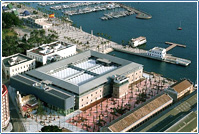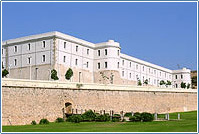The city of Cartagena has a rich tradition and this is especially so in higher technological and economic studies which date back to the XIX/ beginning of the XX century. Let us summarize the development of the University since its beginning so that its current identity can be better understood.
Technological studies
The technological studies that can be studied in Cartagena, as a result of their long history, are widely considered to be pioneering centres for technological science throughout Spain. Indeed, the School of Industrial Engineering was one of the first to be set up in the country, alongside eight other cities, and the School of Mines was the third pioneering centre to be set up in Spain.
MINING STUDIES
The School of Mines Foremen and Engineers dates back to the Royal Decree of 4 September 1883, signed by King Alfonso XIII in San Sebastian. This was the end of a process which had begun in 1865, when the General Direction of Farming, Industry and Trading opened a Training School of Mines in the Cartagena area. However, the lack of funding and the lack of premises postponed the project. The academic freedom proclaimed in 1869 meant that, since 1871, and with economic help from the Town Hall, mining studies could be offered in the high school classrooms under the name of Special School of Masters of Mines.
During the First Republic, in 1873, it was stipulated that the degree titles issued by this School would have the same attributions and official recognition as those issued by the Almaden Training School of Mines. The name of the degree title then became Mines Foremen. It is worth mentioning that the studies of Almaden Mine Foremen date back to 1835, which was when the Almaden Academy of Mines moved to Madrid, with its new name of School of Mines, and practical mining studies were then offered in Almadén (Study Plan in the Royal Order of 23 February, 1841)
The Cartagena School of Mines, depended initially on the Madrid School of Mines in order of hierarchy. Classes in mining were held at the Royal Economic Society of Spain Friends until 1965. Later, the School was moved to the Alameda de San Antón and finally in 1972, re-opened, this time with its own building on Paseo de Alfonso XIII (this building is currently known as "the school of mines").
In the academic field, the most important changes that mining studies have undergone are changes of name and the changes of study plans of the graduates, first to Specialist in Mines and later to Mining Technical Engineers, in accordance with the Technological Education Law, 1964. In 1972, now with the title of Technical School of Mining Engineering, the School became a part of the University of Murcia. From this point, three specialities were given: Mining Exploitation, Metallurgy and Installations of Fuels and Explosives.
INDUSTRIAL STUDIES
According to article 49 of the Royal Decree of 17 August 1901, published by the Public Education and Art Ministry, schools were created with the generic title of Industry Higher Schools in the cities of Madrid, Alcoy, Béjar, Cartagena, Gijón, Las Palmas, Tarrasa, Vigo and Villanueva y La Geltrú. Industrial studies at the Higher School in Cartagena first became available during the 1901/1902 academic year, under the jurisdiction of the University of Valencia and requested by and paid for by the Town Hall. The first premises where the School was located was in the Royal Economic Society of Spain Friends. Later, in 1910, the School was re-opened using the premises of the Town Hall building and in 1918 moved to a hired building on Alameda de San Antón.
From the outset, the School offered the engineering specialities of Electrical, Mechanical and Metallurgical-testing. In 1904 the School applied to include Chemical studies on its curriculum, which was granted by the Ministry in 1907. A year later, in 1908, the studies of perito aparejador (master builder surveyor) were applied for and again granted by the Ministry in the same year. During 1964-1965 the School was moved from the building on Alameda de San Antón to the new Technical School of Industrial Engineering building on Paseo Alfonso XIII, the current architecture studies building. The Ministry paid for the relocation.
By 1972, the following four speciality subjects were established at the School: Engineering Machinery Maker, Structure and Industrial Installations, Electric-Power Lines and Stations and Industrial Electronics. Classes were held in four different buildings on Paseo Alfonso XIII: in the School (currently known as the Industrial Studies building), in the shops (currently the teaching block) and in the gymnasium (recently rebuilt). The fourth building referred to was formerly the Technical School of Industrial Engineering building (currently the Architecture building), in which the Industrial Master studies were housed and in conjunction with the Industrial Surveyor Schools.
ESCUELA UNIVERSITARIA POLITÉCNICA ( POLYTECHNIC SCHOOL)
The creation of La Escuela Universitaria de Cartagena (Polytechnic School) dates back to 1975 and came about when the studies were integrated into the University of Murcia, as a result of the General Education Law. The aims were to integrate the Technical School of Mining Engineering and the Technical School of Industrial Engineering in the University of Murcia and to be able to add other studies to the new Centre. The idea was to create a model educational centre, the first of its kind in Spain, which was needed because the precedent set by the Instituto Politécnico de la Rábida was a poor mixed of vocational training, secondary school and engineering schools.
The process required negotiations in conjunction with the Ministry, represented by the deputy director, the University of Murcia, represented by the Vice-Chancellor for academic planning and the principals of both technical schools.
Finally, the Royal Decree 336 of 21 January 1977 set up la Escuela Universitaria de Cartagena (the Polytechnic School) into which the Naval Architecture School was incorporated. As it did not have any economic endowment or teaching staff, two professorships from the School of Mining and the Technical School of Industrial Engineering were assigned to the Naval Architecture School.
The concept of a "model Centre" was launched and a programming meeting held, chaired by the then Civil Governor of Murcia and attended by the Chancellor of the University of Murcia, the mayor of Cartagena and the principal of the Escuela Universitaria Politécnica (Polytechnic School). In this meeting they agreed on encouraging the development of the future Technical University to be based in Cartagena.
In this sense, it is worth mentioning that the University of Murcia intends to set up a School of Industrial Engineering as a prior step to creating the Technical University of Cartagena. The process evolved through its transition but wasn't passed by the Cabinet. Some years later, the University repeated its request, this time to also incorporate Telecommunication Engineering, Technical Architecture and Technical Agriculture Engineer studies. From the numerous studies that were applied to be granted permission for, the Ministry accepted two: Technical Industrial Engineering, in 1981, and Technical Agriculture Engineering, in 1983, which added to the two already existing specialist degrees.
HIGHER TECHNICAL SCHOOL OF INDUSTRIAL ENGINEERING
In 1989 engineering studies (consisting of an extended second cycle of two years specialised in industrial machine mechanics and industrial electronic and automation) were incorporated. The Higher Technical School of Industrial Engineering was born at this point and it coexisted with la Escuela Universitaria de Cartagena (Polytechnic School) for five years. Indeed, most of the students came from la Escuela Universitaria.
ESCUELA POLITÉCNICA SUPERIOR (HIGHER POLYTECHNIC SCHOOL)
It emerged from the incorporation of the studies of Agronomic Engineering, in 1993, and integrates: Agronomic Engineering, Industrial Engineering, Technical Agricultural Engineering (all the specialities), Technical Mining Engineering (all the specialities) and Naval Architecture Engineering.
Its life was short as it was dissolved in 1996. Following this, the four school were born:
Higher Technical School of Agricultural Engineering
Higher Technical School of Industrial Engineering
Technical School of Mining Engineering
Naval Architecture School
Business Studies
Business studies in Cartagena date back to the Royal Decree of 16 September 1921. The Town Hall paid all expenses until 1940. On 18 October 1932 they were promoted to the level of Professional School of Commerce, enabling the school to offer the studies of Commercial Teaching.
In October 1976, it became Business Studies School, led by the University of Murcia.
Since then it has changed its location several times and the number of students has increased significantly (already there are over one thousand).
Technical University of Cartagena
Under Law 5, 3 August 1998, the Technical University of Cartagena has the following centres:
Higher Technical School of Agricultural Engineering.
Higher Technical School of Industrial Engineering.
Higher Technical School of Telecommunications Engineering.
Technical School of Civil Engineering.
Naval Architecture School.
Faculty of Business Studies.
Affiliated Centres as authorized by law created UPCT:
University School of Labour Relations.
University School of Tourism.










